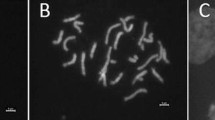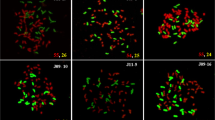Abstract
To determine the taxonomic status and to clarify the biosystematic relationships of wild rice species, i.e.,Oryza granulata andO. meyeriana in theO. meyeriana complex (Poaceae), a series of intraspecific and interspecific hybridization experiments, genomic analyses through meiotic pairing, and morphological studies were conducted. Hybridization results demonstrate comparatively high crossability with about 34–39% of seed set, and very limited reproductive isolation betweenO. granulata andO. meyeriana. Chromosome pairing in the parental species and their F1 hybrids indicate very high genomic affinity between the two taxa. Morphological analyses of the parental accessions and their intra- and interspecific hybrids show a large variation among the samples included, but no appreciable grouping was observed. The traditionally used character, i.e., spikelet length, does not contribute significantly to the grouping of the samples included. Based on the facts that the two taxa have negligible reproductive barriers and share almost identical genomes, the authors believe thatO. granulata andO. meyeriana do not warrant separate taxonomic status, and recommend that they be combined asOryza granulata.
Similar content being viewed by others
References
Aggarwal R. K., Brar D. S., Khush G. S. (1997) Two new genomes in theOryza complex identified on the basis of molecular divergence analysis using total genomic DNA hybridization. Mol. Gen. Genet. 254: 1–12.
Bothmer R. Von., Flink J., Landström T. (1988) Meiosis in interspecificHordeum hybrids. III. Tetraploid (2x × 6x) combinations. Hereditas 108: 141–148.
Chang T. T. (1985) Crop history and genetic conservation: rice — a case study. Iowa State J. of Res. 59: 425–455.
Chang T. T. (1988) Taxonomic key for identifying the 22 species in the genusOryza. Intern. Rice Res. Newsletter 13: 4–5.
Chatterjee D. (1948) A modified key and enumeration of the species ofOryza Linn. Indian J. Agric. Sci. 18: 185–192.
Chevalier A. (1932) Nouvelle contribution a l'etude systematique desOryza. Rev. Bot. Appl. Agric. Sci. 18: 185–192.
Duistermaat H. (1987) A revision ofOryza (Gramineae) in Malaysia and Australia. Blumea 32: 157–193.
Ellis J. L. (1985)Oryza indandamanica Ellis, a new rice plant from islands of Andamans. Bull. Bot. Surv. India 27: 225–227.
Khush G. S., Ling K. C., Aquino R. C., Aguiero V. M. (1977) Breeding for resistance to grassy stunt in rice. In: Proc. 3rd Intern. Congr. SABRAO, pp. 3–9. Canberra, Australia.
Khush G. S., Multani D. S., Vergara G. V., Brar D. S. (1990) Taxonomic status ofOryza indandamanica. Rice Genet. Newsletter 7: 141–142.
Kimber G. (1983) Genome analysis in the genusTriticum. In: Sakamoto S. (ed.) Proc. 6th Intern. Wheat Genet. Symposium, pp. 23–28. Kyoto, Japan.
Lin S. C., Yuan L. P. (1980) A mass screening method for testing grassy stunt disease of rice. Hybrid rice breeding in China, pp. 33–51. In: Innovative approaches to rice improvement. International Rice Research Institute. Los Baños, Philippines.
Lu B. R. (1993) Genomic relationship within theElymus parviglumis group (Triticeae: Poaceae). Plant Syst. Evol. 187: 191–211.
Lu B.-R., Bothmer R. Von (1990) Intergeneric hybridization betweenHordeum and AsiaticElymus. Hereditas 112: 109–116.
Lu B.-R., Naredo M. E. B., Juliano A. B., Jackson M. T. (1997) Hybridization of AA genome rice species from Asia and Australia. II. Meiotic analysis ofOryza meridionalis and its hybrids. Genetic Resources and Crop Evolution 44: 25–31.
Minitab (1994) Minitab Statistical Software Release 10 for Windows. Minitab Inc.
Morinaga T. (1941) Cytogenetical studies onOryza sativa L. V. The cytogenetics of F1 hybrid ofO. sativa L. andO. latifolia Desv. Jap. J. Bot. 11: 461–478.
Murashige T., Skoog F. (1962) A revised medium for rapid growth and bioassays with tobacco cultures. Physiol. Plant. 15: 473–497.
Naredo M. E. B., Lu B.-R., Juliano A. B., Jackson M. T. (1997) Hybridization of AA genome rice species from Asia and Australia. I. Crosses and development of hybrids. Genetic Resources and Crop Evolution 44: 17–24.
Ogawa T., Katayama T. (1971) Cytogenetical studies on the genusOryza. V. Chromosome pairing in the interspecific hybrids between genomes A and B (O. punctata). Japan. J. Breed. 21: 151–154.
Rohlf F. J. (1994) NTSYS-pc Numerical Taxonomy and Multivariate Analysis System Version 1.80. Exeter Software, New York.
Roschevicz R. (1931) A contribution to the knowledge of rice (Translation from Russian). Bull. Appl. Bot. Genet. Plant Breeding 27: 1–133.
Sharma S. D., Shastry S. V. S. (1965) Taxonomic studies in the genusOryza. VI. A modified classification. Indian J. Genet. 25: 173–178.
Snow R. (1963) Alcoholic hydrochloric acid-car-mine as stain for chromosome squash preparation. Stain Technol. 38: 9–13.
Statistix (1996) Statistix analytical software. P. O. Box 12185, Tallahassee Fl 32317-2185, USA.
Tateoka T. (1962) Taxonomic studies ofOryza II. Several species complexes. Bot. Mag. Tokyo 75: 455–461.
Tateoka T. (1963) Taxonomic studies ofOryza. III. Key to the species and their enumeration. Bot. Mag. Tokyo 76: 165–173.
Vaughan D. A. (1989) The genusOryza L: current status of taxonomy. IRRI Res. Paper Ser.138, IRRI Los Baños Philippines.
Vaughan D. A. (1994) The wild relatives of rice: A genetic resources handbook. IRRI, Los Baños, Philippines.
Wu W. C., Lu Y. G., Wang G. C. (1990) A revision on the scientific and Chinese name of the verrucose wild rice indigenous to China. Chinese J. Rice Sci. 4: 33–37.
Yoshida S., Forno D. A., Cock J. H., Gomez K. A. (1976) Routine procedures for growing rice plants in culture solution. In: Laboratory Manual for Physiological Studies of Rice, IRRI. Los Baños, Philippines.
Author information
Authors and Affiliations
Rights and permissions
About this article
Cite this article
Gong, Y., Borromeo, T. & Lu, B.R. A biosystematic study of theOryza meyeriana complex (Poaceae). Pl Syst Evol 224, 139–151 (2000). https://doi.org/10.1007/BF00986339
Received:
Accepted:
Issue Date:
DOI: https://doi.org/10.1007/BF00986339




